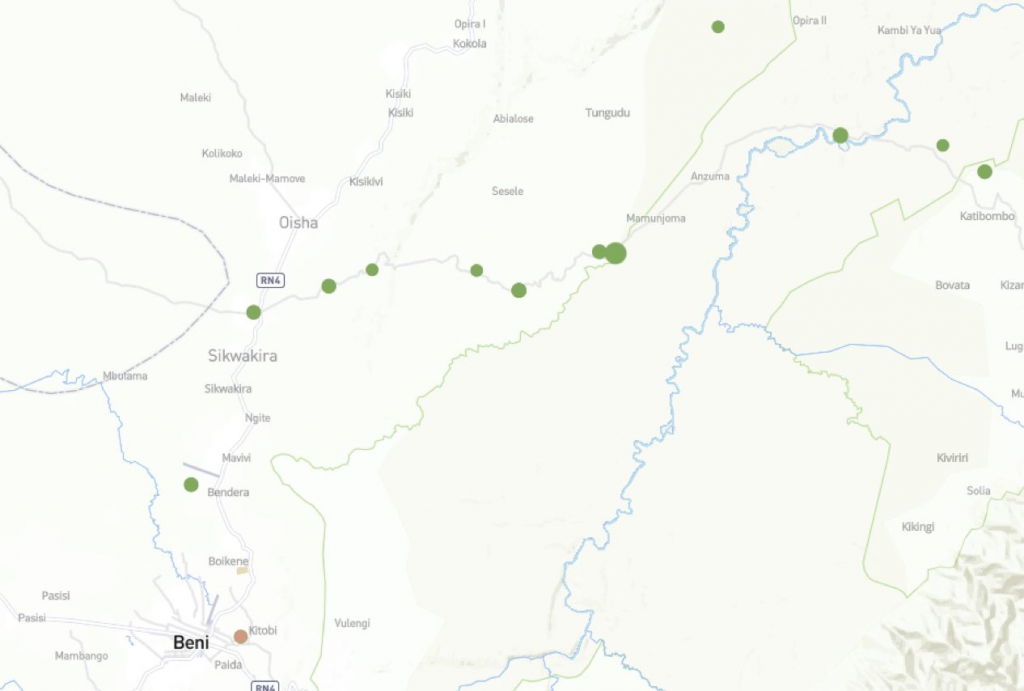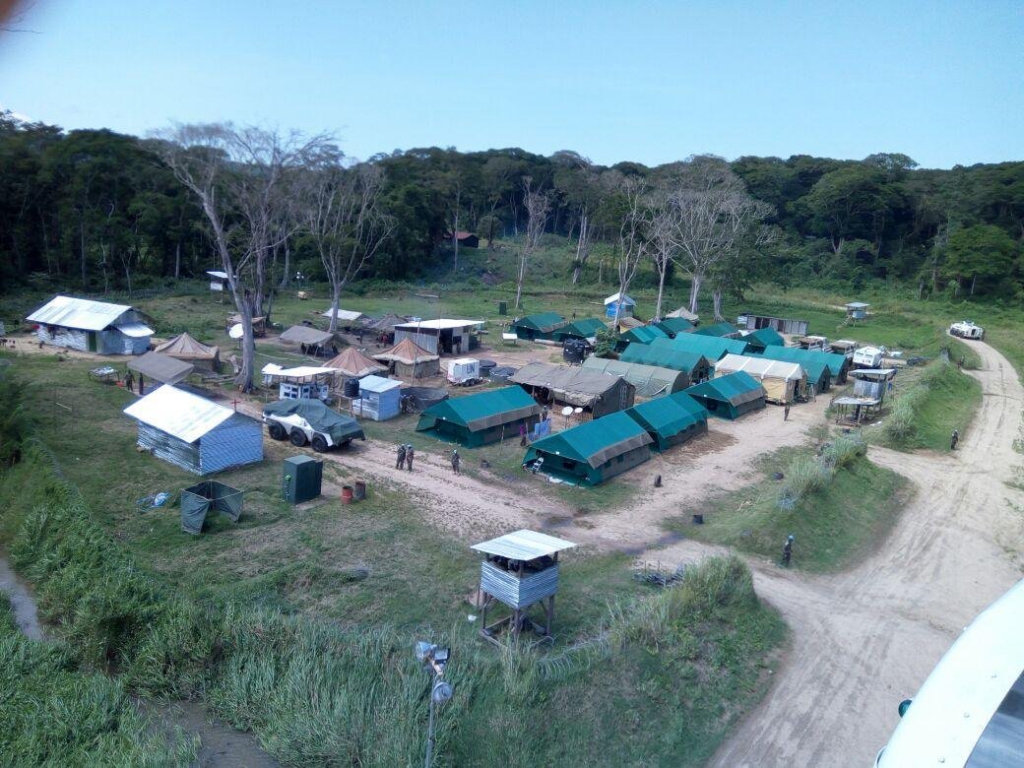On Thursday evening, a UN military base on the banks of the Semuliki river in northeastern Congo was attacked. According to initial news reports and conversations with Congolese army (FARDC) and MONUSCO officials, the attackers were wearing FARDC uniforms and attacked a small FARDC platoon next to the base before entering the compound. At around 5pm, the Tanzanians alerted the MONUSCO base in Beni that they were under attack from three different sides. Shortly afterwards, the communication lines were cut.
The UN’s response will be the matter of much scrutiny in coming days: Although the head of UN peacekeeping, Jean-Pierre Lacroix, says that they responded as soon as they were informed, reportedly the first reconnaissance flight did not leave until 7am the following morning––the Tanzanian peacekeepers were cut off for over 12 hours, left to fend for themselves. The FARDC also had a base around 15 km away; it is unclear whether they were informed of the attack.
In the morning, the tragic aftermath became clear: At least 15 dead, over fifty wounded––some in critical condition––and three peacekeepers missing. This was the worst attack on UN peacekeepers in recent history (I believe since the killing of 24 Pakistani peacekeepers in Mogadishu in 1993) and the deadliest ever on Congolese soil (nine Bangladeshi peacekeepers were killed in Ituri in 2005).
The attack was part of a battle for the control of the Mbau-Kamango road that goes through the Virunga park, crosses the Semuliki river, and leads to the Ugandan border at Nobili. On October 7, alleged ADF attacked traders on the road, killing 26. Two days later, on the same road, the ADF attacked the MONUSCO base in Mamundioma along the same road, killing two peacekeepers. After six days of fighting, the FARDC and MONUSCO took back control of the road on October 13. Our Kivu Security Tracker map shows ADF attacks and killings along this road in the past three months (the attack on the Tanzanian base took place where the road crosses the Semuliki river):

Here are the key questions, and some tentative answers, about the attack (see here and here for other analyses):
1. Who is responsible?
The UN has pointed the finger at the Allied Democratic Forces (ADF), an Islamist Ugandan rebellion that has been based in the eastern Congo since the early 1990s. The group has developed strong ties with local figures and armed groups, and, with the exception of some spectacular attacks and killing, for much of the twenty-some years it has been in the region, was not much more abusive than other armed groups in the vicinity. This changed when the group became the focus of attacks by the Congolese government and the UN, beginning in 2005. Large scale massacres against civilians then began following the launch of Operation Sokola I in 2014 and lasted until mid-2015. After a lull, other attacks took place in late 2016.
According to two extensive investigations by CRG, the ADF were involved in those massacres. But other, local dynamics are equally important. Former members of a local rebellion, the APC, which used to control this area between 1999-2003 and that still has a large base in the region, were also involved in those killings, as were militias of the Pakombe and Vuba communities, which have long felt marginalized by the majority Nande community. All of these groups––the ADF, the APC, and the local militia––have deep historical ties. In addition, we found that senior members of the FARDC were also involved in the latter stages of the massacres.
Another key feature of the attack was the overwhelming firepower that the attackers reportedly had. According to preliminary reports, they hit the camp with rocket-propelled grenades and heavy machine guns. This is part of a trend. One FARDC officer recently told me regarding fighting in October: “I have been fighting the ADF here since 2014. But something has happened. They suddenly got a lot stronger.”
The ADF were likely involved––our map of their area of operations shows how close they are to this road––and given their history in the region, it is possible that they worked with other armed groups.

However––revealing how these incidents are perceived by Congolese––broader speculation has also bubbled up on Congolese social media and in the press. The director of local NGO, Jean-Paul Ngahangondi, cast doubt on the ADF’s responsibility, saying that it is a small group that never carried attacks like this. Some drew links to the meeting the same day between Congolese and Ugandan officials about border security, suggesting that the attack was part of new plan to justify joint Uganda-DRC operations against the ADF.Since the attack occurred, a civil society group seen as close to the FARDC has called for joint operations.
Others said it might be the Rwandan and Congolese armies.
Meanwhile, Felix Tshisekedi, one of the most important opposition leaders, said that the purpose of the attack was to prompt the UN peacekeeping mission to leave.
2. What is MONUSCO’s responsibility?
The mission is in a difficult position. It has been criticized often, and over many years, of not being aggressive enough in protecting civilians. In response, it has recently adopted a “protection through projection” approach, deploying smaller groups of peacekeepers in critical areas instead of staying inside large bases, and building relations with local communities. This approach may be reviewed in the Beni area, where MONUSCO troops are increasingly being targeted.
But there are more concrete questions that will be asked. Why did the attack helicopters, which are equipped with night-vision equipment, take so long to get there? One MONUSCO official suggested that they cited bad weather––but bad weather for 12 hours? Was the base––shown on the picture below––too poorly defended in an area where an attack was predictable? Did the FARDC also not react quickly enough?

3. How important is this?
The attack will have a huge impact on the UN deployments and strategy in the Congo and beyond. It may lead to a renewed offensive against the ADF––hopefully coupled with a better understanding of exactly who is behind the killings. It may lead to more joint operations between the Ugandan and Congolese armies, and it will definitely strengthen the Congolese government’s argument that the problem of Beni is one of Islamist terrorism.
It is also useful to put this in perspective. While this incident made international news––CNN, France24, and BBC TV covered it––Beni is only one of many theaters of violence in the Congo. There have been at least 528 killings of civilians in North and South Kivu in the past six months, 91 of which took place in Beni territory and 40-50 of which may be be attributed to the ADF, depending on how one counts. Around 13% of the displaced people in the Kivus are in Beni territory.
There is indeed something afoot in the eastern Congo––armed groups are mobilizing, and the country has seen more displacement this year than any other place in the world. There are many factors behind this, but it is also clear that armed groups are influenced by political turmoil in Kinshasa. They are political animals, sensing an upcoming rupture––elections or something else––and are positioning themselves. However the UN and the international community responds, it is important to keep that in mind.
